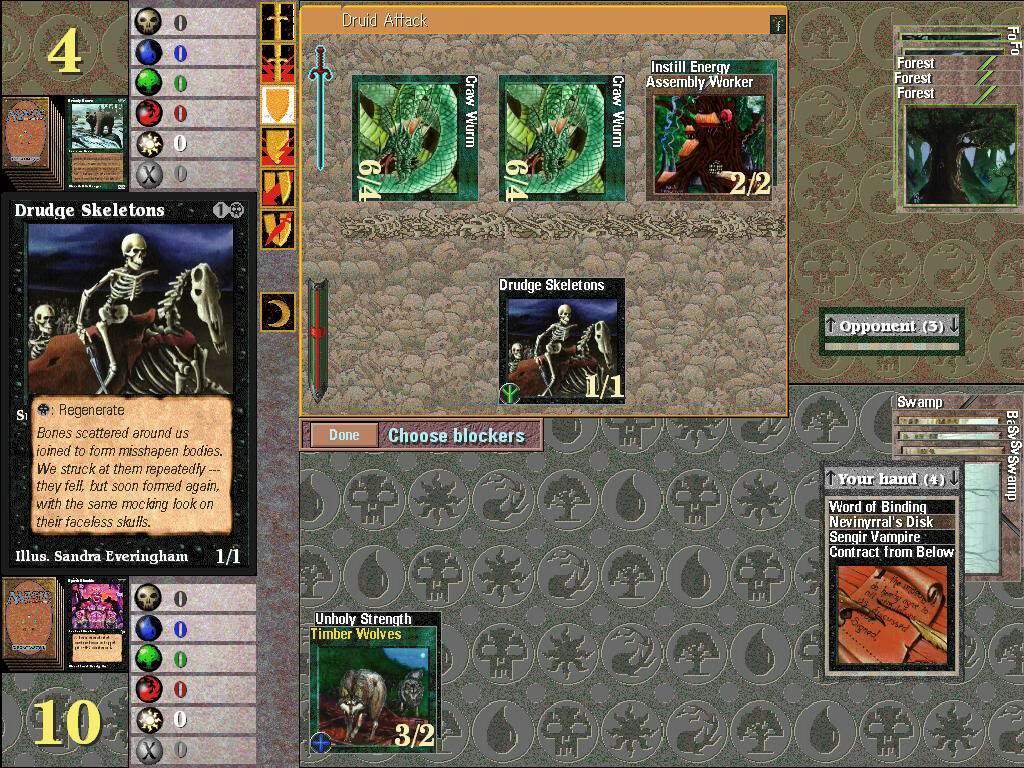

That means some different strategies from the ones championship players are used to, which amounts to more variety and more interesting gameplay. And the final boss has ludicrous amounts of life. One thing that's interesting is that it does not follow standard MtG rules: both wizards do not start with 20 hit points each, it's more like ~5-7 in the beginning of the game, and then you earn more life as the game progresses. The AI was not spectacularly strong, but sufficient for having fun.

Magic: The Gathering Shandalar (as I knew it back then, to avoid confusion with other Magic-related games) was not only a card-based game, but it had a lighweight "RPG" element to it, since you started with a minimal deck and had to battle other wizards and go to towns to buy cards, and to dungeons to find rare powerful cards. There are many types of cards: enchantment (which typically lasts infinitely, as long as it's maintained and not destroyed), creatures (which you summon), instant (spells that can be cast only once the card must be discarded after use), land (gives our mana), artifacts, and more.The name does not indicate it, but this is a demo only (like most classic games in the archive). You will therefore find many regeneration cards and forest creatures in this discipline. Green, on the other hand, represents Earth. Therefore, there are many blue illusion spells, and 99% of all blue monsters you can summon can swim. Blue, for example, is water, which prefers illusions and guile. disciplines of magic, each with its own characteristic appropriate to that element. The rules are too intricate to go into detail here - suffice it to say that there are 5 colors, i.e. The game is turn-based, with each turn comprising several phases. When an enemy is encountered, the player will be taken to the Duel screen to fight the battle.įor the uninitiated (and have never played Master of Magic before), Magic: The Gathering the card game pits two players, as powerful wizards, against each other in a magical duel, where each wizard can cast spells, summon monsters, and invoke various enchantments or curses. He will encounter dungeons and crypts populated by monsters of different varieties, each equipped with a deck of Magic cards accentuating strengths in certain types of magic. As play progresses, the player will discover new cards hidden on the map, as well as have the opportunity to buy those of his choosing. The player's responsibility is to travel the world of Shandalar, dueling creatures and wizards for control of the magical land. For those of a more adventurous ilk, an RPG-like adventure game is also included. Decks created in this way can be saved, and tested against the decks of the AI opponents. To aid the player in building a killer deck, a Deck Builder utility is also included with the product, enabling the player to add cards to or delete cards from his deck. Players can duel in single-match mode against one opponent, or in a ladder-style tournament against a collection of opponents. First, the player can simply play the card game against opponents sporting different decks.

There are a couple of different varieties of gaming available in Magic: The Gathering, although they are all geared toward playing the card game itself.


 0 kommentar(er)
0 kommentar(er)
